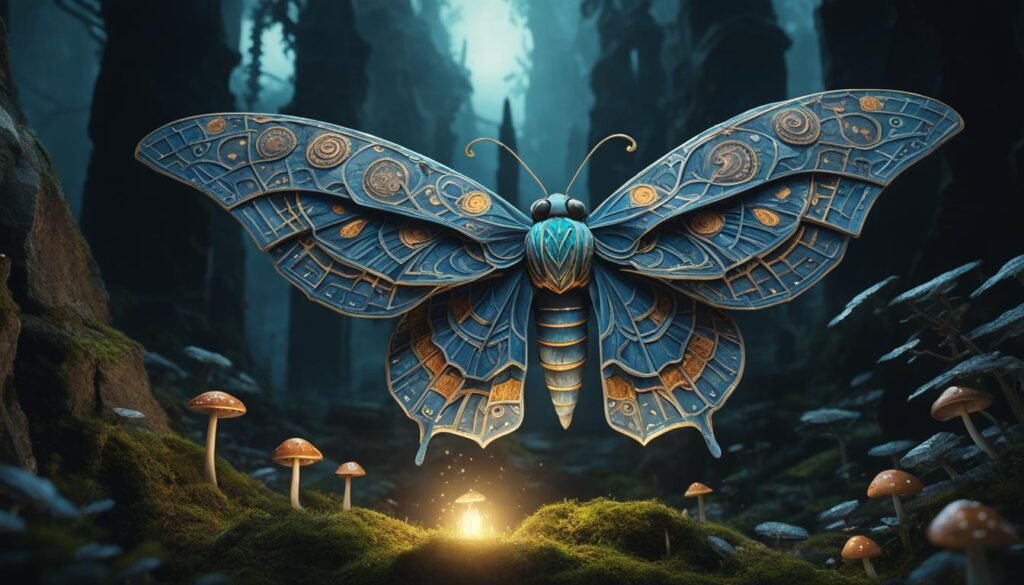Death is never an easy topic to discuss, especially when it comes to insects. However, even the death of a small creature like a moth can hold significant meaning and symbolism. In this section, we will explore the intricacies behind the dead moth meaning and symbolism. Throughout the article, we will discuss the different beliefs and interpretations associated with this phenomenon, ranging from cultural beliefs and superstitions to spiritual practices and animal symbolism.
Key Takeaways:
- Dead moths hold significant meaning and symbolism in various cultures and spiritual beliefs.
- The symbolic meaning of moths represents transformation and spiritual journey.
- Moths can serve as guides in personal and spiritual growth as totems and power animals.
- The presence of a dead moth can signify transition, change, and the impermanence of life.
- Interpreting the presence of a dead moth requires consideration of various factors and discernment of its symbolic significance in one’s life.
Symbolic Meaning of Moth
The moth is a nocturnal insect that is often associated with the concept of transformation and spiritual journey. The symbolic meaning of moths varies across different cultures and beliefs, but they have long been seen as messengers from the spiritual realm.
In Native American cultures, moths are considered sacred animals and are believed to be carriers of ancient wisdom and knowledge. They are often seen as symbols of self-discovery and personal transformation, as they undergo a profound metamorphosis from a caterpillar to a butterfly.
In Chinese culture, the moth is believed to be a symbol of death and rebirth. It is seen as a reminder of the impermanence of life and an encouragement to embrace change and transformation.
Interestingly, despite their association with death and the darker aspects of life, moths are also seen as symbols of hope, guidance, and protection. In many cultures, encountering a moth is believed to be a sign of good luck and spiritual guidance.
At the heart of the symbolic meaning of moths is the idea of spiritual transformation. Whether viewed as messengers, guides, or symbols of change, moths offer us the opportunity to embrace the unknown and embark on a journey of inner growth and self-discovery.
Moth Spiritual Meaning
Throughout history, moths have been regarded as powerful symbols of spiritual transformation and guidance. In various spiritual practices and belief systems, moths are believed to be messengers from the spirit world, carrying profound messages from beyond. The spiritual symbolism of a moth is often associated with the idea of metamorphosis and the journey of the soul towards enlightenment.
In many cultures, the moth is seen as a symbol of the human soul, striving towards its spiritual evolution. The moth is believed to hold a unique connection to the divine realm, and its presence is often seen as a sign of spiritual awakening and transformation. This spiritual symbolism also relates to the idea of surrendering to the flow of life and accepting the impermanent nature of all things.
Additionally, the moth’s affinity for light is believed to represent the yearning for spiritual enlightenment. The way a moth is drawn to the light is seen as a symbol of the human soul’s longing for union with the divine.
Overall, the spiritual symbolism of a moth is strongly related to the concept of transformation, guidance, and surrender. The moth serves as a reminder of the journey of the soul towards enlightenment and the importance of following the path illuminated by the divine.
Moth Totem and Power Animal
Many cultures view moths as powerful totems and spiritual guides, representing qualities and characteristics that can aid individuals in their personal growth and journey towards enlightenment. As a totem, moth energy is associated with transformation, intuition, and vulnerability. Similar to the stages of metamorphosis that moths undergo, individuals who identify with moth energy may be experiencing a period of change and evolution in their lives.
As a power animal, the moth is known for its keen perception and intuitive abilities, able to navigate through darkness and confusion with ease. Moth power is said to guide individuals towards their higher purpose and assist them in uncovering hidden truths and insights.
The symbolic associations of moths as totems and power animals vary across cultures, but certain qualities are commonly attributed to them. In many traditions, moths are seen as messengers from the spirit realm, conveying important messages and guidance to those who are receptive to their energy.
Moth totem and power animal energy can be channeled through meditation, visualization, and ritual practices. Those looking to connect with their inner moth energy may benefit from spending time in nature, particularly at night when moths are most active.
Moth Dream Symbolism
In the realm of dream symbolism, moths hold a significant role and can convey unique messages to the dreamer. As an insect drawn to light, a moth in a dream could represent the longing for spiritual illumination.
Alternatively, a moth in a dream could signify a time of vulnerability and metamorphosis. Just as a moth undergoes a transformation from a caterpillar to a winged insect, the dreamer may be going through a period of change and growth.
It is essential to consider the context and emotions present in the dream to interpret the significance of a moth’s presence. For example, if a moth appears in a dream after a loved one’s passing, it may symbolize the spirit of that person making contact.
“What does it mean to dream of a moth? In short, it may mean that a major change is imminent or that you need to prepare for a significant revelation.” – Alexandra Chauran, author of “Crystal Ball Reading for Beginners.”
Moth in Mythology
The moth’s symbolism and significance have been woven into the fabric of various mythologies throughout history. In Greek mythology, the moth was associated with the god of love, Eros. Legend has it that the moth would flutter around his flame, the symbol of passion and desire, before eventually immolating itself in the blaze. This served as a metaphor for the dangers of pursuing one’s desires blindly without considering the consequences.
In Chinese mythology, the moth was believed to be the soul of a departed loved one returning to visit the living. Its appearance was seen as a sign of good luck and prosperity for the household. The moth was also associated with the goddess of silk, who taught the Chinese people the art of sericulture, or silk production.
Native American tribes, including the Hopi and Navajo, viewed the moth as a symbol of introspection and transformation. The Hopi believed that the moth’s ability to undergo metamorphosis from a humble caterpillar to a majestic creature was indicative of the potential for growth and change within all individuals.
The presence of moths in mythology reflects their universal symbolism and serves as a testament to their enduring significance throughout human history.

Cultural Beliefs about Dead Moths
Dead moths have long been a source of cultural beliefs and superstitions. In many cultures, their presence is considered a sign of good or bad luck.
For instance, in some Native American traditions, dead moths indicate the presence of a spirit trying to convey a message. They are seen as messengers from the other world, urging the living to pay attention to their surroundings and listen to their inner voice.
On the other hand, in some Asian cultures, dead moths are considered an ill omen. They are believed to bring bad luck, especially if they are found inside the house. In Chinese folklore, for example, a dead moth is an omen of death and is believed to be a sign of an impending tragedy or misfortune.
In Western cultures, dead moths are often seen as a warning of an approaching change or transformation. Many people believe that seeing a dead moth is a sign that they need to embrace change and let go of the past to move forward.
“Dead moths have been a focus of spiritual and superstitious beliefs across many cultures and traditions for centuries.”
The Symbolic Meaning of a Dead Moth
The symbolic meaning of a dead moth can vary depending on the culture and belief system. However, it generally represents the idea of impermanence and the ephemeral nature of life. Just like the moth’s life cycle, which ends in death, our lives are also fleeting and temporary. Therefore, seeing a dead moth can serve as a reminder to embrace the present moment and cherish what we have while we can.
The Significance of Color
The color of a dead moth can also hold symbolic meaning. In many cultures, black or brown moths are associated with death and negativity, while white or light-colored moths are seen as symbols of purity, innocence, and spiritual transformation.
| Color | Meaning |
|---|---|
| Black | Potential death or negativity |
| Brown | Transitional period |
| White | Purity, innocence, and spiritual transformation |
It’s important to note that these beliefs and interpretations are not universal and can vary widely depending on the culture, tradition, and individual context.
Folklore and Superstitions about Dead Moths
Dead moths have long been the subject of folklore and superstitions in many cultures around the world. Some believe that a dead moth is a sign of bad luck, while others see it as a symbol of impending death. In some cultures, encountering a dead moth is believed to foretell a visitor or news.
One common superstition associated with dead moths is that they carry the souls of departed loved ones. In some cultures, if a dead moth is found inside the home, it is believed that a deceased relative is trying to communicate with the living.
Another belief surrounding dead moths is that they have the power to ward off evil spirits. In some cultures, placing a dead moth in a sachet or amulet is believed to protect against negative energies and bring good luck.
Some cultures believe that killing a moth will bring about a curse or bad luck, while others see it as a symbol of disrespect towards nature and a warning of karmic retribution.
“For many people, encountering a dead moth is a spiritual experience that carries deep meaning and significance.”
Dead Moth as a Symbol of Transition and Change
Throughout history, moths have been seen as powerful symbols of transformation and change. The sight of a dead moth can serve as a reminder of the impermanence of life and the constant cycles of growth and decay that we all experience.
The symbolism of a dead moth is rooted in its life cycle. Moths go through a metamorphosis from egg to caterpillar to cocoon to adult, with each stage signifying growth and transformation. When a moth dies, it represents the end of one stage and the beginning of another. The cycle of life, death, and rebirth is an important theme in many spiritual and philosophical traditions, and the dead moth serves as a powerful symbol of this concept.
The symbolism of a dead moth can also represent a need for change in one’s life. Just as moths undergo a transformation to reach their adult form, humans must go through periods of change and growth to reach their full potential. The dead moth can serve as a powerful reminder to embrace change and let go of the past in order to move forward in life.
Moreover, the dead moth can signify a need to let go of old habits, patterns, and beliefs to make way for new ones. It can be a powerful call to action to break free from stagnation and embrace the winds of change.
The dead moth is a potent symbol of transition and change, reminding us that life is a fleeting and ever-changing journey filled with both beauty and pain. By embracing this symbolism and the lessons it contains, we can learn to navigate the cycles of life with grace and acceptance.
Dead Moth as a Sign of Spiritual Transformation
While the physical death of a moth may seem insignificant, it holds deep symbolic value in spiritual belief systems. The dead moth meaning conveys the transformation and spiritual growth that occur when one sheds their old self and allows the new to emerge.
The moth spiritual meaning associates the soul’s journey towards enlightenment as a process of transformation where the old beliefs, habits, and patterns of thinking must be shed for new ideas to blossom. The death of a moth signifies the end of a cycle and the beginning of a new one, emphasizing the transient nature of life and the need to embrace change as a necessary element in personal and spiritual growth.
Just like the moth that undergoes metamorphosis, emerging from its cocoon as a new and transformed creature, humans too can undergo spiritual metamorphosis. The moth symbolizes the potential for change and the importance of embracing transformational moments.
“The dead moth reminds us that transformational growth may require the painful shedding of old beliefs and ways of being, but the freedom and spiritual growth that emerge from the struggle are worth it.”
Moth Spiritual Significance in Different Belief Systems
| Tradition/Belief System | Moth Spiritual Significance |
|---|---|
| Ancient Egyptians | Viewed the moth as a symbol of rebirth and transformation |
| Native American culture | Considered the moth as a spirit guide, aiding in deep spiritual transformation |
| Chinese culture | Believed in the transformative powers of the moth’s ability to navigate through darkness and emerge into the light |
| Western culture | Associated the moth with the soul’s journey towards enlightenment and spiritual growth |
The moth’s symbolism is prevalent in various spiritual traditions and belief systems, emphasizing its importance as a symbol of transformation and personal growth.
Interpreting the Presence of Dead Moths
Encountering a dead moth can evoke various emotions, from surprise to unease, and for some, even fear. However, in many cultures and spiritual traditions, a dead moth is seen as a symbol of transformation and spiritual growth. Interpreting the presence of dead moths can be a way to understand the messages they may be conveying to you.
When interpreting a dead moth’s presence, some factors to consider are its location, timing, and appearance. For example, finding a dead moth in a place where it is unusual, such as your bedroom or in a room where you don’t usually spend much time, may indicate that an unexpected change is coming your way. On the other hand, encountering a dead moth during a time of significant personal transformation or when undergoing a major life change, such as a move or a new job, may convey a message of support and guidance.
The appearance of a dead moth can also hold symbolic significance. Take note of its color, size, and patterns on its wings as these can indicate specific messages that relate to your life situation. For example, a brown moth may represent stability and grounding, while a white moth may indicate purity and transformation.
Furthermore, interpreting the presence of a dead moth can also involve examining your own emotions connected to this experience. Pay attention to your first reactions or thoughts when encountering a dead moth, as they may help you understand what message the moth is conveying to you personally.
While interpreting the presence of a dead moth can give you insights into your life journey, remember that ultimately, the way you decipher its meaning depends on your own intuition and personal beliefs.
Conclusion
Throughout history, moths have held a significant place in various cultures and belief systems. The symbolism associated with them is diverse and multifaceted, ranging from transformation to spirituality to death and rebirth.
When it comes to encountering a dead moth, the interpretation can depend on individual beliefs and experiences. Some may view it as a sign of spiritual guidance or transformation, while others may see it as a natural occurrence with no deeper significance.
Regardless of personal beliefs, the presence of a dead moth can serve as a reminder of the fleeting nature of life and the constant state of change that we all experience. By embracing this impermanence, we can learn to navigate life’s transitions with grace and mindfulness.
In conclusion, the meaning and symbolism of a dead moth are complex and layered. It is up to each individual to interpret its significance based on their own beliefs and experiences. However, one thing is certain- the presence of a dead moth can serve as a catalyst for personal and spiritual growth, reminding us of the cyclical nature of existence and the limitless potential for transformation and renewal.
FAQ
What is the meaning and symbolism behind a dead moth?
The meaning and symbolism behind a dead moth can vary depending on cultural beliefs and personal interpretations. In general, a dead moth is often seen as a representation of transformation and the impermanence of life. It can be seen as a metaphor for change and the cyclical nature of existence.
What is the symbolic meaning of moths?
Moths are often associated with symbolism related to transformation, intuition, vulnerability, and attraction to light. They are seen as creatures that navigate the darkness of the night and symbolize the journey of the soul and spiritual growth.
What is the spiritual meaning of a moth?
In spiritual practices and belief systems, moths are seen as messengers and symbols of spiritual guidance and transformation. They are believed to bring messages from the spirit realm and signify the need for inner exploration and growth.
How are moths seen as totems and power animals?
Moths are often seen as totems and power animals, representing qualities such as determination, adaptability, sensitivity, and spiritual guidance. They serve as guides in one’s personal and spiritual growth, assisting in navigating through life’s challenges and transitions.
What does it mean when a moth appears in dreams?
The appearance of a moth in dreams can carry various interpretations. It may symbolize transformation, the subconscious mind, intuition, or spiritual messages. The context of the dream and the emotions evoked by the presence of the moth can provide further insights into its meaning.
How are moths portrayed in mythology?
Moths are present in various mythologies throughout history, often associated with concepts such as rebirth, transcendence, and transformation. They can be seen as symbols of the soul’s journey or as messengers between different realms of existence.
What are the cultural beliefs and superstitions surrounding dead moths?
Different cultures have different beliefs and superstitions surrounding dead moths. Some cultures see them as omens of death or bringers of bad luck, while others view them as messengers from departed loved ones or symbols of transformation and spiritual enlightenment.
Are there any folklore or superstitions related to encountering dead moths?
Yes, there are various folklore and superstitions related to encountering dead moths. Some believe that seeing a dead moth inside a house signifies impending death, while others associate the presence of dead moths with messages from the spirit world or warnings of approaching changes.
What does a dead moth symbolize in terms of transition and change?
A dead moth can symbolize transition and change, highlighting the impermanence of life and the need to embrace transformation. It serves as a reminder that change is an essential part of existence and that it is necessary to adapt and evolve in order to grow.
How can a dead moth be seen as a sign of spiritual transformation?
The physical death of a moth can be seen as a metaphor for the spiritual transformation and growth of the soul. It represents the shedding of old beliefs, patterns, and limitations, allowing for spiritual evolution and the emergence of a higher consciousness.
How can one interpret the presence of dead moths?
Interpreting the presence of dead moths requires considering various factors such as personal beliefs, emotions evoked, and cultural references. It is important to trust one’s intuition and inner wisdom to discern the symbolic significance of a dead moth in one’s life and the messages it may be conveying.



